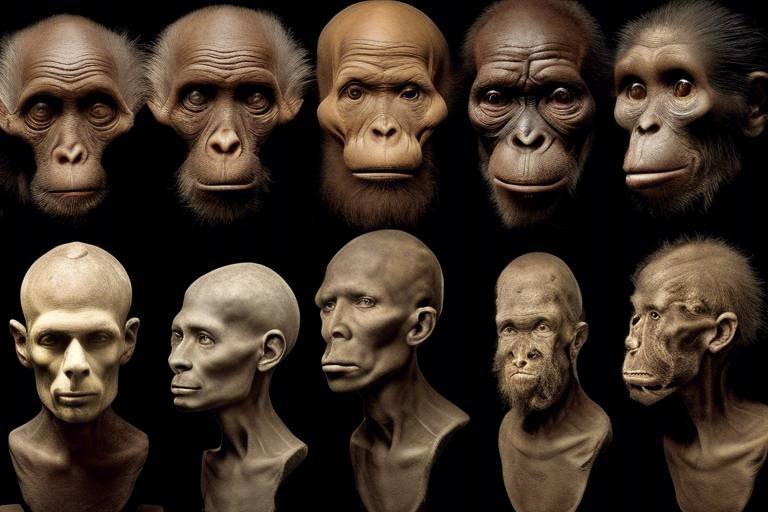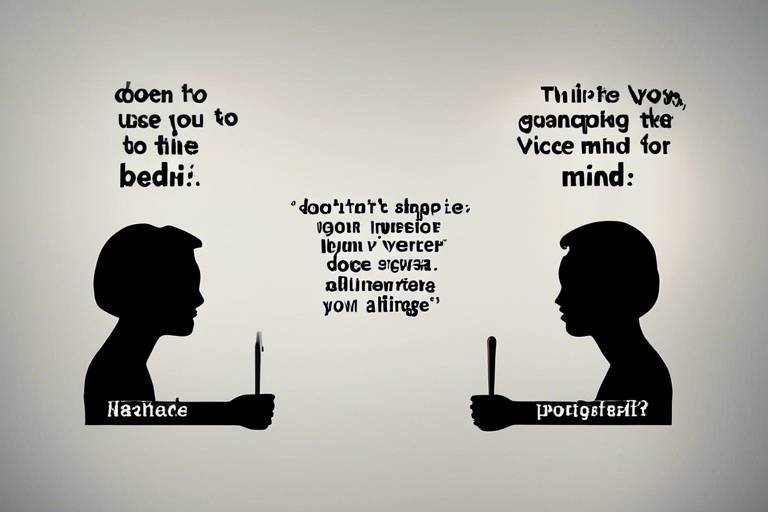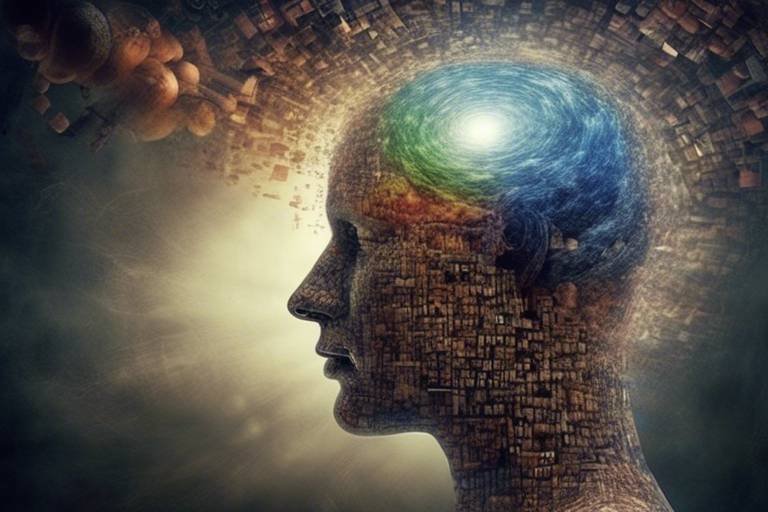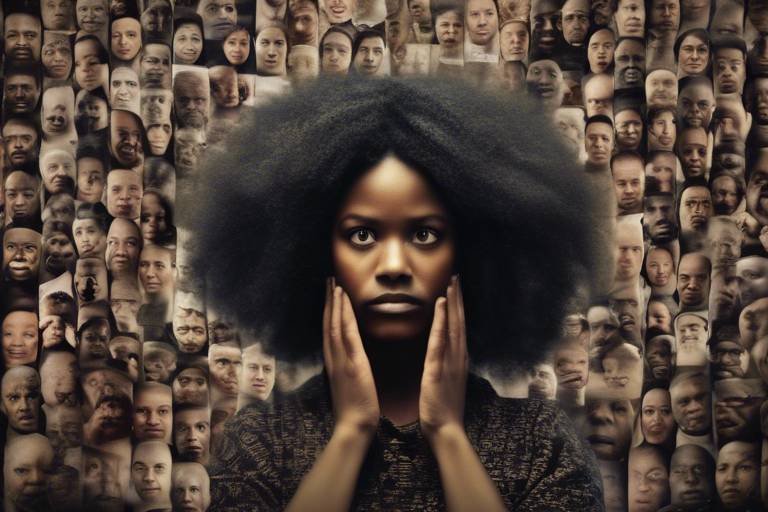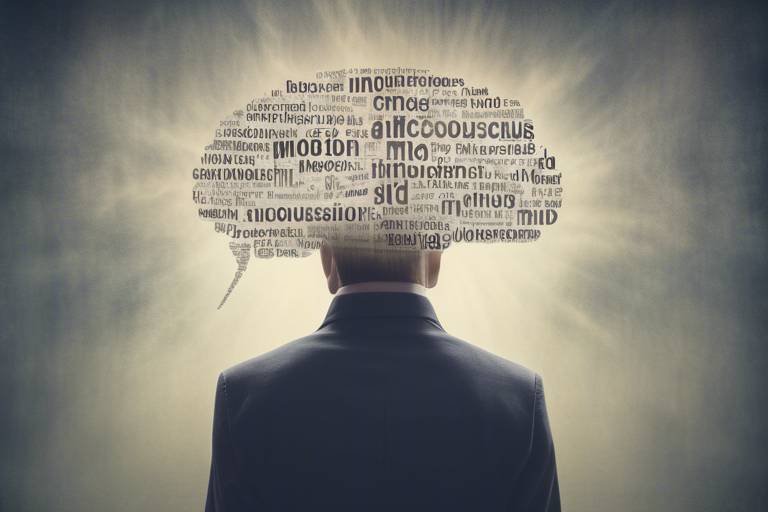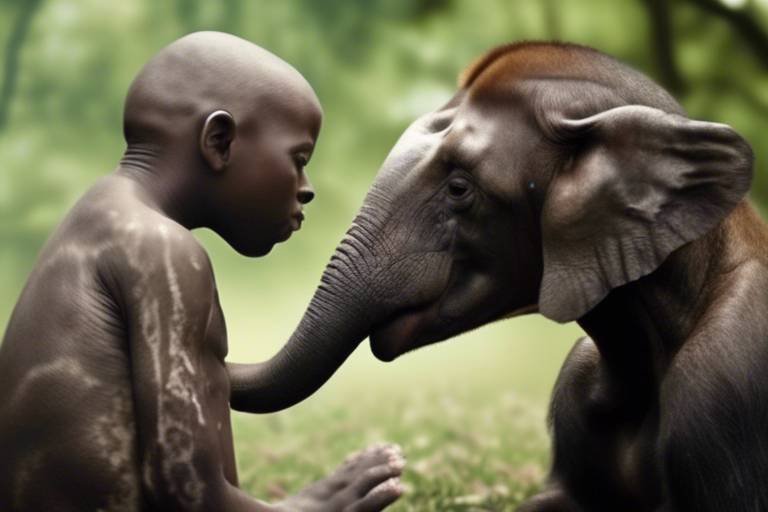The Evolution of Human Mind - An Anthropological Examination
This article explores the development of human cognition and consciousness through an anthropological lens, examining key milestones and their implications for understanding our species' unique mental capabilities. The journey of the human mind is not just a tale of biological evolution; it is also a story of cultural evolution, social interactions, and the intricate web of language that binds us together. By delving into our past, we can uncover the layers of complexity that have shaped our thoughts, behaviors, and interactions as a species.
The origins of human cognition can be traced back to our early hominin ancestors, who navigated their environments with a level of intelligence that set them apart from other species. These early beings faced challenges that required innovative problem-solving skills and adaptability. Imagine a time when survival hinged on the ability to recognize patterns, create tools, and communicate effectively with others in the group. This was the dawn of human thought, where the seeds of cognition began to sprout.
Early hominins developed basic thought processes that allowed them to adapt to their surroundings. They learned to forage, hunt, and gather, which demanded a keen understanding of their environment. The cognitive leap from mere survival to strategic planning marked a pivotal moment in our evolution. As these early humans interacted with one another, they began to form social structures that further enhanced their cognitive abilities. The need to cooperate and share knowledge became crucial, leading to a more sophisticated understanding of the world around them.
Language is a fundamental aspect of human cognition. It is the thread that weaves together our thoughts, emotions, and social interactions. The development of language has profoundly shaped our thinking, enabling us to express complex ideas and share experiences across generations. Without language, our ability to communicate and collaborate would be severely limited. Think about it: how would we convey our thoughts, feelings, and knowledge without the rich tapestry of words and symbols?
Examining the connection between language and social behavior reveals how linguistic capabilities have influenced group dynamics and cooperation among early human communities. Language allowed for the sharing of information, fostering a sense of belonging and unity. It helped establish social norms and cultural practices that guided behavior within groups. As communities grew, so did the complexity of their interactions, leading to the rich tapestry of human relationships we see today.
The emergence of symbolic thought in language illustrates how symbols have allowed for abstract thinking and the sharing of complex ideas. Early humans began to use symbols to represent objects, actions, and concepts, paving the way for storytelling and cultural transmission. This ability to think symbolically not only enhanced communication but also allowed for the exploration of abstract concepts such as time, morality, and existence itself. The power of symbols is evident in the way we communicate today, from art to literature, each medium serving as a vehicle for shared understanding.
Various theories on the evolution of language provide insights into how language may have developed as a tool for survival and social cohesion. Some scholars argue that language evolved from primitive gestures, while others suggest that vocalizations played a crucial role. Regardless of its origins, the development of language has been a game-changer for humanity, allowing us to build societies, share knowledge, and create cultures. It’s fascinating to consider how this unique ability has influenced our evolution as a species.
Focusing on the cognitive processes involved in language acquisition, we see how children learn language and its implications for understanding human cognitive development. From babbling to forming complete sentences, the journey of language acquisition is a remarkable process. Children absorb linguistic input from their environment, and through interaction, they begin to make sense of the world around them. This natural inclination to learn language highlights the innate cognitive abilities present in humans, showcasing our capacity for communication and understanding.
Culture plays a significant role in shaping human thought processes. The beliefs, values, and practices of a society influence how individuals perceive and interact with the world. Cultural practices often dictate problem-solving approaches, ethical considerations, and even emotional responses. For instance, in collectivist cultures, group harmony may take precedence over individual desires, affecting decision-making processes and social interactions. Understanding the interplay between culture and cognition is essential for grasping the full picture of human development.
Investigating how different cultures approach problem-solving and reasoning highlights the diversity of cognitive styles across various societies. Some cultures may emphasize analytical thinking, while others prioritize holistic approaches. This cultural variability in thinking not only enriches our understanding of human cognition but also underscores the importance of context in shaping our mental frameworks. It’s a reminder that there is no single way to think or reason; rather, our cognitive processes are influenced by the tapestry of cultural experiences we encounter.
The influence of rituals on cognitive growth is profound. Cultural practices can enhance memory, social learning, and shared knowledge within communities. Rituals often create a sense of belonging and identity, reinforcing social bonds and shared values. They serve as a framework for transmitting knowledge and cultural heritage, ensuring that important lessons and traditions are passed down through generations. This connection between rituals and cognitive development illustrates how deeply intertwined our minds are with our cultural practices.
- What is the significance of language in human evolution?
Language has been pivotal in shaping human cognition, enabling complex communication, social interactions, and cultural development. - How do cultural practices influence cognitive processes?
Cultural practices shape how individuals perceive the world, approach problem-solving, and interact with others, leading to diverse cognitive styles. - What role do rituals play in cognitive development?
Rituals enhance memory and social learning, fostering a sense of community and shared knowledge among individuals.

Origins of Human Cognition
The origins of human cognition are a fascinating journey that takes us deep into the evolutionary past, tracing the roots of our thought processes and problem-solving abilities back to our early hominin ancestors. Imagine a time when our ancestors roamed the earth, facing challenges that required more than just instinct to survive. It was in these moments of necessity that the seeds of cognitive development began to sprout, leading to the complex minds we possess today. Early hominins, such as Australopithecus and later species like Homo habilis, exhibited rudimentary forms of thinking that were crucial for adapting to their environments. These adaptations included the use of tools, which marked a significant milestone in cognitive evolution.
As early humans navigated their landscapes, they encountered various obstacles that demanded innovative solutions. For instance, crafting tools from stone not only required a basic understanding of cause and effect but also involved planning and foresight. This ability to manipulate the environment showcased a shift from mere survival instincts to a more advanced form of cognitive engagement. It's like learning to ride a bike; at first, it seems daunting, but with practice, you gain balance, control, and ultimately, freedom. Similarly, our ancestors learned to balance their needs with their surroundings, paving the way for future cognitive advancements.
Moreover, the development of social structures among early hominins played an essential role in shaping cognition. Living in groups necessitated communication and cooperation, leading to the evolution of social intelligence. As individuals began to interact more with one another, they developed the ability to understand others' perspectives—a vital component of what we now call theory of mind. This capacity to recognize and interpret the mental states of others was not just beneficial for social cohesion; it also sparked the beginnings of complex problem-solving and collaborative strategies. Picture a group of early humans hunting together; their ability to communicate effectively and coordinate their efforts was crucial for their success.
In essence, the origins of human cognition can be seen as a tapestry woven from various threads: environmental challenges, tool-making, social interaction, and the gradual emergence of symbolic thought. Each of these elements contributed to a burgeoning cognitive framework that would eventually enable the development of language, culture, and sophisticated problem-solving skills. Understanding these origins not only sheds light on our past but also provides valuable insights into the unique mental capabilities that define us as a species today.
- What are the key milestones in the evolution of human cognition?
Key milestones include the development of tool-making, social cooperation, and the emergence of language, all of which contributed to advanced cognitive abilities.
- How did environmental challenges influence cognitive development?
Environmental challenges necessitated innovative problem-solving and adaptability, driving cognitive evolution in early hominins.
- What role does social interaction play in cognitive growth?
Social interaction fosters communication and collaboration, enhancing cognitive skills and the ability to understand others' perspectives.

The Role of Language
Language is not just a means of communication; it is the very essence of what makes us human. It serves as a powerful tool that shapes our thoughts, connects us with others, and influences our social structures. Imagine trying to convey your deepest feelings or complex ideas without the rich tapestry of language at your disposal. It's like trying to paint a masterpiece with only a single color. The development of language has been pivotal in enhancing our cognitive abilities, allowing us to express abstract concepts, share experiences, and build intricate societies.
From the earliest forms of communication, such as gestures and simple sounds, language has evolved into a sophisticated system of symbols and rules. This evolution has not only transformed how we communicate but has also fundamentally altered our cognitive processes. For instance, the advent of language enabled early humans to engage in more complex problem-solving and planning. It allowed them to collaborate more effectively, share knowledge, and pass down cultural narratives through generations. In essence, language has been a catalyst for our cognitive development, enabling us to think critically and creatively.
When we think about language, we cannot overlook its profound impact on social interaction. Language acts as a bridge that connects individuals, fostering relationships and promoting cooperation. Early human communities relied heavily on their linguistic capabilities to navigate social dynamics. For example, the ability to articulate needs, negotiate conflicts, and establish bonds was crucial for survival. In a way, language can be seen as the glue that holds societies together.
Moreover, the nuances of language have shaped our social behaviors over time. Different cultures have developed unique languages and dialects, each reflecting their values and beliefs. This diversity in linguistic expression enriches our global tapestry and highlights the importance of understanding and respecting different cultures. For instance, consider how some languages have specific terms for concepts that may not exist in others. This linguistic richness allows for a broader understanding of human experience and thought.
One of the most fascinating aspects of language is its capacity for symbolism. Through symbols, we can express complex ideas and emotions that go beyond mere words. Think about how a simple word can evoke a myriad of feelings or memories. This ability to use symbols for abstract thinking has been crucial in the development of human cognition. It allows us to conceptualize the past, envision the future, and discuss hypothetical scenarios. In many ways, symbols serve as the building blocks of our thoughts, enabling us to construct intricate mental frameworks.
As we delve deeper into the role of language, it’s essential to consider the various theories surrounding its evolution. Scholars have proposed multiple hypotheses to explain how language may have developed as a tool for survival and social cohesion. For example, some theories suggest that language emerged as a means of coordinating group activities, such as hunting or gathering. Others posit that it evolved from early forms of social bonding, where vocalizations played a role in strengthening relationships.
Regardless of the specific pathway, it is clear that language has been integral to our survival as a species. The ability to communicate effectively has allowed humans to adapt to diverse environments, share knowledge, and build communities. In this light, language is not merely a byproduct of evolution; it is a fundamental aspect of our identity as humans.
Understanding the role of language in cognition also requires us to examine how children acquire language. The process of language acquisition is a remarkable journey that showcases the innate capabilities of the human mind. From babbling as infants to forming complex sentences, children demonstrate an incredible ability to learn and adapt to linguistic structures. This rapid development is not just about mimicking sounds; it involves cognitive processes that shape their understanding of the world.
Research has shown that children learn language through interaction with their environment, particularly through social engagement. This highlights the importance of communication in cognitive development, as children learn not only words but also the social norms and cultural contexts that accompany them. The implications of this are profound, as it suggests that fostering a rich linguistic environment can significantly enhance cognitive growth.
- What is the primary role of language in human cognition?
Language serves as a tool for communication, thought expression, and social interaction, significantly enhancing our cognitive abilities. - How does language influence social behavior?
Language facilitates relationships and cooperation, acting as a bridge that connects individuals and communities. - What are some theories about the evolution of language?
There are various theories, including those suggesting language emerged for coordination in group activities or as a means of social bonding. - How do children acquire language?
Children acquire language through interaction and engagement with their environment, showcasing their innate cognitive abilities.

Language and Social Interaction
Language is not just a tool for communication; it's the very fabric that weaves together the social interactions of human beings. Imagine a world without language—how would we share our thoughts, feelings, or even our basic needs? The evolution of language has profoundly influenced how we connect with one another. From the earliest grunts and gestures of our ancestors to the complex languages we speak today, the journey of language reflects our development as a social species. The ability to articulate thoughts and emotions has enabled humans to form intricate social bonds, creating communities that thrive on cooperation and mutual understanding.
When we look at early human societies, we can see that language served as a catalyst for social interaction. It allowed individuals to coordinate efforts in hunting, gather resources, and ultimately survive. Consider this: without a shared language, how could early humans have effectively communicated the location of food or alerted others to danger? Language facilitated not only survival but also the sharing of knowledge, traditions, and cultural values. This is why linguistic capabilities are often seen as a cornerstone of social behavior.
Furthermore, the way language shapes social interaction is multifaceted. For instance, consider the role of non-verbal cues—gestures, facial expressions, and tone of voice—all of which enhance our verbal communication. Together, they create a rich tapestry of meaning that goes beyond mere words. In fact, studies have shown that a significant portion of our communication is non-verbal. This interplay between verbal and non-verbal elements highlights the complexity of social interactions and the importance of context in understanding messages.
To illustrate this, let’s take a closer look at how language fosters group dynamics. In many cultures, specific phrases or terms are used to establish rapport and community. For example, greetings and expressions of gratitude can strengthen bonds among individuals. Language serves as a social glue, binding people together and fostering a sense of belonging. When we communicate effectively, we enhance our relationships and promote cooperation.
Additionally, language can influence social hierarchies and power dynamics within a group. The way we use language can assert dominance or express solidarity. For instance, leaders often employ persuasive language to inspire and motivate their followers, while individuals may use inclusive language to promote teamwork and collaboration. This demonstrates how language is not just about exchanging information; it's also a powerful tool for shaping social structures.
In summary, the relationship between language and social interaction is intricate and vital for human development. Language has evolved to serve as a vehicle for expressing thoughts, emotions, and cultural identity, enabling us to interact meaningfully with one another. As we continue to explore the depths of human cognition, it becomes increasingly clear that language is not merely a means of communication—it is the essence of our social existence.
- How did language first evolve in humans?
Language likely evolved as a means of enhancing social interaction and cooperation among early humans, facilitating communication about resources and social dynamics. - What role does non-verbal communication play in language?
Non-verbal communication, such as gestures and facial expressions, complements verbal language, enhancing understanding and emotional expression in social interactions. - Can language influence our thoughts?
Yes, the language we use can shape our thoughts and perceptions, a concept known as linguistic relativity, which suggests that different languages can lead to different ways of thinking.

Symbolism in Language
Language is not merely a collection of sounds or symbols; it is a powerful tool that allows us to communicate complex ideas, emotions, and experiences. At the heart of this capability lies the concept of symbolism. Symbols are more than just words; they are representations of ideas, objects, and emotions that transcend their physical forms. For instance, when we hear the word "freedom," it evokes a myriad of feelings and images that go beyond the mere definition of the term. This ability to use symbols enables humans to engage in abstract thinking, allowing us to conceptualize and discuss things that are not immediately present or tangible.
Throughout history, the emergence of symbolic thought has been pivotal in the development of human culture and society. Early hominins likely used rudimentary symbols to convey basic ideas, but as language evolved, so did the complexity of these symbols. This evolution has allowed for the sharing of complex ideas and narratives, fostering a sense of community and shared understanding among individuals. For example, consider how ancient cave paintings served as a form of symbolic communication, depicting not just the hunt but also the spiritual beliefs and social structures of the time.
Moreover, the use of symbolism in language has profound implications for our cognitive processes. It allows us to categorize our experiences and express thoughts that might otherwise be difficult to articulate. When we use metaphors, such as describing life as a "journey," we draw on familiar concepts to explain complex experiences. This not only enriches our communication but also enhances our understanding of the world around us.
To illustrate the significance of symbolism in language, let’s consider a few examples:
- Colors: In many cultures, colors carry symbolic meanings. For instance, red can symbolize love or danger, while white often represents purity or peace.
- Numbers: Certain numbers have symbolic significance, such as the number 7, which is often associated with luck or spirituality.
- Animals: Animals can symbolize various traits; for example, an owl symbolizes wisdom, while a lion represents courage.
These examples highlight how symbols can encapsulate deep meanings and cultural values, making communication not just a transfer of information but a rich tapestry of shared understanding. As we delve deeper into the study of language and symbolism, we uncover the intricate ways in which our cognitive abilities have been shaped by the very tools we use to express ourselves.
In conclusion, the symbolism in language is a testament to the unique cognitive capabilities of humans. It allows for the expression of abstract concepts, facilitates social bonding, and enriches our understanding of the world. As we continue to explore the evolution of language, it becomes increasingly clear that our ability to create and interpret symbols is fundamental to what it means to be human.
- What is the significance of symbolism in language?
Symbolism allows us to convey complex ideas and emotions, enriching communication and enhancing understanding. - How does symbolism affect cognitive development?
Symbolism fosters abstract thinking and categorization, helping individuals articulate and process their experiences. - Can symbolism vary across cultures?
Yes, different cultures may attribute different meanings to symbols, which can influence communication and social interactions.

Language Evolution Theories
Understanding the evolution of language is like piecing together a fascinating puzzle that spans millennia. Various theories have emerged, each providing unique insights into how language may have developed as a vital tool for survival and social cohesion among early humans. These theories not only help us comprehend the origins of our communication but also reveal the intricate relationship between language and human cognition.
One prominent theory is the **“Bow-Wow Theory,”** which suggests that language originated from humans imitating the sounds of nature. Imagine early humans observing animals and mimicking their calls; this could have been a primitive way to communicate essential information, like the presence of danger or food. While this theory captures the imagination, it is often criticized for oversimplifying the complex nature of language.
On the other hand, the **“Ding-Dong Theory”** posits that there is an inherent connection between sounds and meanings. This theory suggests that certain sounds naturally evoke particular feelings or ideas, much like how a bell’s sound might resonate with a sense of alertness. This concept aligns with the idea that language may have evolved from innate human responses to the environment, allowing for a deeper understanding of our surroundings.
Another influential perspective is the **“Social Interaction Theory.”** This theory emphasizes the importance of social dynamics in language development. It proposes that as early humans began to form more complex social structures, the need for effective communication became paramount. Language, in this context, served as a tool for **cooperation, negotiation, and community building.** The ability to share stories, convey emotions, and express thoughts would have significantly enhanced group survival, fostering a sense of belonging and shared identity.
Furthermore, the **“Cognitive Development Theory”** highlights the role of cognitive processes in language evolution. According to this theory, as human brains evolved and became more sophisticated, so did our capacity for abstract thought and complex communication. This perspective suggests that language is not only a means of communication but also a reflection of our cognitive abilities, allowing us to articulate thoughts, emotions, and ideas in increasingly elaborate ways.
To illustrate the diversity of these theories, let’s summarize them in the following table:
| Theory | Description |
|---|---|
| Bow-Wow Theory | Language originated from imitating natural sounds. |
| Ding-Dong Theory | Inherent connections exist between sounds and meanings. |
| Social Interaction Theory | Language evolved to meet the needs of social dynamics. |
| Cognitive Development Theory | Language reflects the evolution of cognitive abilities. |
Each of these theories contributes to our understanding of how language may have evolved, yet they also raise intriguing questions about the nature of communication itself. For instance, can we truly separate language from the cognitive processes that shape our thoughts? Or is language an extension of our innate social instincts? As we explore these theories, it becomes evident that language is not merely a tool but a complex interplay of cognitive, social, and environmental factors.
In conclusion, the evolution of language is a rich tapestry woven from various threads of thought. As anthropologists and linguists continue to investigate these theories, we gain deeper insights into not just how we communicate, but also how we think, relate, and ultimately define our humanity.
- What are the main theories of language evolution? The main theories include the Bow-Wow Theory, Ding-Dong Theory, Social Interaction Theory, and Cognitive Development Theory, each offering unique perspectives on how language may have originated.
- How does language influence human cognition? Language shapes our thoughts and perceptions, allowing for abstract thinking and complex communication, thereby influencing how we understand the world around us.
- Can animals communicate like humans? While animals have their own forms of communication, human language is distinct in its complexity and ability to convey abstract concepts.
- Why is understanding language evolution important? Understanding language evolution helps us grasp the development of human cognition and social structures, providing insights into our unique mental capabilities.

Language Acquisition in Children
Language acquisition in children is a fascinating process that showcases the innate ability of humans to learn and use language. From the moment a baby is born, they are surrounded by sounds and voices that will shape their understanding of the world. It's almost like watching a flower bloom; the roots are laid down in the early months, and as the child grows, their language skills blossom into complex forms of communication.
Research indicates that children go through several stages of language acquisition, each marked by significant milestones. Initially, infants engage in cooing and babbling, which are essential precursors to actual speech. During this phase, they experiment with sounds, practicing the rhythm and melody of their native language. It's as if they are tuning their instruments before the grand performance of conversation begins.
As children reach around 12 months, they typically begin to speak their first words. This is a monumental moment for both the child and their caregivers. Words like "mama" and "dada" are often the first to emerge, serving as both a means of expression and a way to bond with their parents. This early vocabulary is often limited, but it lays the groundwork for more complex language skills.
Between the ages of 2 and 3, children enter what is known as the "two-word stage," where they start combining words to form simple sentences. For instance, a child might say "more juice" or "big truck," demonstrating an understanding of grammar and syntax, even if it's not perfect. This stage is crucial as it marks the transition from single words to more complex structures, allowing children to express their desires and needs more effectively.
By the time children reach preschool age, their vocabulary expands exponentially. It's not uncommon for a 4-year-old to have a vocabulary of several hundred words. They begin to grasp the concept of storytelling and can recount simple events, illustrating their cognitive development. At this point, the influence of social interactions becomes increasingly evident. Children learn language not just from their caregivers but also from peers, showcasing the importance of social environments in language acquisition.
The process of language acquisition is influenced by various factors, including:
- Social Interaction: Engaging with others is crucial. Children who are spoken to more often tend to develop language skills faster.
- Exposure to Language: The richness of language exposure, including books and conversations, plays a significant role.
- Cultural Context: Different cultures have unique ways of using language, which can affect how children learn and use it.
Moreover, the role of play in language development cannot be overstated. Playful interactions, whether through games or imaginative scenarios, provide children with opportunities to practice language in a fun and engaging way. This is where the magic happens; through play, children learn to negotiate, express emotions, and understand social cues—all vital components of effective communication.
In summary, language acquisition in children is a dynamic and multifaceted process that reflects their cognitive and social development. As they progress from cooing infants to articulate storytellers, they not only learn words but also how to connect with the world around them. This journey is not just about learning to speak; it's about forming relationships, expressing individuality, and understanding the complex tapestry of human interaction.
Q: At what age do children typically start speaking their first words?
A: Most children say their first words around 12 months of age.
Q: How can parents support their child's language development?
A: Engaging in conversations, reading books, and encouraging play are effective ways to support language growth.
Q: What role does social interaction play in language acquisition?
A: Social interaction is crucial as it provides children with opportunities to practice and refine their language skills.
Q: Are there different stages of language development?
A: Yes, children typically progress through stages including cooing, babbling, single words, two-word phrases, and more complex sentences.

Impact of Culture on Cognition
The intricate tapestry of human cognition is significantly woven with the threads of culture. From the moment we are born, we are enveloped in cultural practices that shape our thoughts, behaviors, and perceptions. Have you ever stopped to think about how your upbringing influences the way you solve problems or interact with others? Culture is not merely a backdrop; it is a powerful force that molds our cognitive frameworks. The way we think, reason, and even feel is often a reflection of the cultural environment we inhabit.
One of the most fascinating aspects of this relationship is how cultural practices and beliefs create distinct cognitive styles. For instance, in some cultures, individualism is celebrated, while in others, collectivism takes center stage. This divergence can lead to different approaches in problem-solving. In individualistic cultures, people might tackle challenges independently, valuing personal achievement. Conversely, in collectivist societies, the focus may shift towards group consensus and collaboration, emphasizing harmony and shared responsibility. This cultural variability in thinking not only affects interpersonal relationships but also influences how communities innovate and adapt to their surroundings.
Moreover, rituals play a crucial role in cognitive development. They serve as structured activities that foster social learning and memory. Consider how children learn through repetitive cultural rituals, such as storytelling or communal celebrations. These practices enhance their ability to absorb knowledge and internalize social norms. For example, in many Indigenous cultures, oral traditions are paramount, allowing for the transmission of wisdom across generations. This method of learning not only preserves cultural heritage but also sharpens cognitive skills, as individuals engage in critical thinking and interpretation of the stories shared.
To illustrate the impact of culture on cognition, let’s look at a table that summarizes key differences in cognitive styles across various cultures:
| Cultural Aspect | Individualistic Cultures | Collectivist Cultures |
|---|---|---|
| Problem-Solving Approach | Independent | Collaborative |
| Value of Personal Achievement | High | Moderate |
| Communication Style | Direct | Indirect |
| Social Relationships | Loose | Tight-knit |
As we can see, these differences in cultural frameworks lead to distinct cognitive patterns. This highlights the necessity of understanding cultural context when examining human cognition. It’s not just about the brain; it’s about the environment in which that brain operates. The interplay of culture and cognition is a dance that continues throughout our lives, influencing every decision we make and every interaction we have.
In conclusion, culture is a vital component of cognitive development that shapes our thoughts, behaviors, and interactions. By recognizing the profound influence of cultural practices, we can better understand the rich diversity of human cognition. So, the next time you find yourself pondering why someone thinks differently than you, remember that their cultural background plays a significant role in shaping their perspective.
- How does culture influence problem-solving?
Culture shapes the way individuals approach challenges, with some cultures favoring independent solutions while others emphasize collaboration. - What role do rituals play in cognitive development?
Rituals enhance memory and social learning, allowing individuals to internalize cultural norms and knowledge through structured activities. - Can cognitive styles change with cultural exposure?
Yes, exposure to different cultures can lead to shifts in cognitive styles as individuals adapt to new social norms and practices.

Cultural Variability in Thinking
When we think about how people from different parts of the world solve problems or approach life’s challenges, it’s like looking at a colorful tapestry woven from countless threads of culture, experience, and environment. reveals that our cognitive processes are not just a product of biology but are deeply influenced by the cultural contexts in which we are raised. For instance, consider how a child growing up in a collectivist society, where community and family are prioritized, might approach a problem differently than a child from an individualistic society, where personal achievement and independence are emphasized.
Research has shown that these cultural differences can significantly impact cognitive styles. In societies that value holistic thinking, individuals are more likely to see the big picture and consider the relationships between elements in their environment. On the other hand, those from cultures that emphasize analytical thinking tend to focus on individual components and categorize them. This distinction can be illustrated through a simple table:
| Cognitive Style | Holistic Thinking | Analytical Thinking |
|---|---|---|
| Focus | Big picture, context | Details, categories |
| Common Cultures | East Asian societies | Western societies |
| Problem-Solving Approach | Interconnectedness | Separation of elements |
This table highlights just a few aspects of how cultural backgrounds inform our cognitive processes. For example, in East Asian cultures, it’s common for individuals to consider the context and relationships surrounding a situation, which can lead to more collaborative problem-solving methods. In contrast, Western cultures often encourage a more competitive and individualistic approach, where standing out and showcasing personal achievements is the norm.
Moreover, cultural rituals and practices play a significant role in shaping how we think. For instance, storytelling traditions in Indigenous cultures not only pass down knowledge but also encourage critical thinking and creativity among listeners. These narratives often engage the audience in a way that promotes reflection and deeper understanding, contrasting sharply with more didactic teaching methods found in many Western educational systems.
Ultimately, understanding cultural variability in thinking is crucial for fostering better communication and collaboration in our increasingly globalized world. By recognizing that different cognitive styles stem from unique cultural backgrounds, we can appreciate the richness of human thought and the diverse ways in which we interpret our surroundings. This awareness can lead to more effective teamwork, conflict resolution, and innovation across cultural boundaries.
- What is cultural variability in thinking? It refers to the differences in cognitive processes influenced by cultural contexts, affecting how individuals perceive and solve problems.
- How does culture influence cognition? Culture shapes our beliefs, values, and practices, which in turn affect our thought processes and decision-making styles.
- Can understanding cultural variability improve communication? Yes! Recognizing different cognitive styles can enhance interpersonal communication and collaboration in diverse settings.

Rituals and Cognitive Development
Rituals are more than just repetitive actions; they are the threads that weave together the fabric of human cognition and culture. From ancient tribal ceremonies to modern-day family traditions, rituals serve as a powerful tool for cognitive development. They help individuals, particularly children, to make sense of their world, build social bonds, and enhance their memory. Think about it: when you participate in a ritual, you're not just going through the motions; you're engaging in a shared experience that reinforces collective knowledge and values.
One of the most fascinating aspects of rituals is their ability to create a structured environment for learning. Children often learn best through repetition and routine, and rituals provide just that. For instance, consider a simple family dinner where everyone shares their day. This isn't just a meal; it's a ritual that fosters communication, encourages storytelling, and strengthens familial bonds. During these moments, children pick up language skills, social cues, and even emotional intelligence. They learn to express themselves and understand others, all while participating in a cherished tradition.
Moreover, rituals can enhance memory retention. Research has shown that engaging in ritualistic behavior can improve recall and understanding of information. This is because rituals often involve multiple sensory experiences—sights, sounds, and even smells—that create a rich context for learning. For example, think about how the smell of a specific dish can trigger memories of family gatherings. This sensory connection reinforces cognitive pathways, making it easier to remember related concepts.
In many cultures, rituals are also tied to significant life events, such as births, marriages, and deaths. These rituals not only mark transitions but also provide a framework for understanding complex emotions and social dynamics. They offer a communal space where individuals can share their experiences, thus fostering a sense of belonging and identity. Through participation in these rituals, individuals learn about their culture’s beliefs and values, which in turn shapes their cognitive processes.
To illustrate the impact of rituals on cognitive development, consider the following table that summarizes key benefits:
| Benefit | Description |
|---|---|
| Enhanced Memory | Rituals create rich sensory experiences that improve recall. |
| Social Learning | Participating in rituals fosters communication and social skills. |
| Cultural Identity | Rituals reinforce cultural values and personal identity. |
| Emotional Understanding | They provide a framework for processing complex emotions. |
In conclusion, rituals are not merely cultural artifacts; they are essential components of cognitive development. They help individuals navigate the complexities of social interactions, enhance memory, and foster a sense of belonging. The next time you find yourself participating in a ritual, whether it's a holiday celebration or a simple family gathering, take a moment to appreciate the cognitive magic at play. These practices are a testament to the intricate relationship between culture and cognition, shaping not just how we think, but who we are.
Q1: How do rituals influence cognitive development in children?
A1: Rituals provide a structured environment for learning, enhancing memory retention and social skills through repetition and shared experiences.
Q2: Can rituals have a positive impact on emotional intelligence?
A2: Yes, rituals often involve processing complex emotions in a communal setting, which helps individuals understand and express their feelings better.
Q3: Are there specific rituals that are more beneficial for cognitive development?
A3: While all rituals can be beneficial, those that involve storytelling, communal activities, and sensory experiences tend to have a greater impact on cognitive growth.
Frequently Asked Questions
- What are the origins of human cognition?
The origins of human cognition can be traced back to early hominins, who developed thought processes and problem-solving abilities as adaptations to their environments. These cognitive developments were crucial for survival, enabling our ancestors to navigate challenges and utilize resources effectively.
- How has language impacted human cognition?
Language plays a fundamental role in shaping human cognition. It not only facilitates communication but also influences the way we think and perceive the world. Through language, we can express complex ideas, share knowledge, and build social structures, which are essential for cooperation and community building.
- What is the relationship between language and social interaction?
Language and social interaction are deeply intertwined. The development of linguistic capabilities has significantly influenced group dynamics, allowing for better cooperation and collaboration among early human communities. By communicating effectively, individuals could coordinate actions and strengthen social bonds.
- How did symbolic thought emerge in language?
Symbolic thought emerged as humans began to use symbols to represent abstract concepts. This ability to think symbolically allowed for more complex communication and the sharing of intricate ideas, paving the way for advanced cognitive and cultural developments.
- What are some theories regarding the evolution of language?
Various theories on the evolution of language suggest that it may have developed as a tool for survival and social cohesion. Some theories propose that language evolved from gestures and vocalizations used for communication in social groups, while others emphasize its role in enhancing cooperation and group identity.
- How do children acquire language?
Children acquire language through a combination of innate abilities and social interaction. As they grow, they learn to communicate by mimicking sounds, understanding grammar, and engaging with caregivers. This process is vital for cognitive development, as it shapes their understanding of the world.
- In what ways does culture influence cognition?
Culture significantly influences cognition by shaping the beliefs, practices, and values that inform how individuals think and reason. Different cultures may approach problem-solving in unique ways, leading to diverse cognitive styles that reflect their specific social contexts and experiences.
- How do rituals enhance cognitive development?
Rituals play a crucial role in cognitive development by enhancing memory and social learning. Through repeated cultural practices, individuals can share knowledge and reinforce social bonds, which contribute to the collective cognitive growth of their communities.

